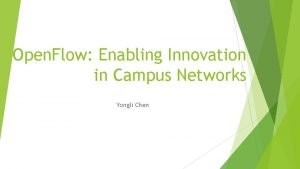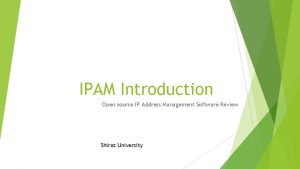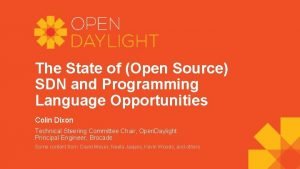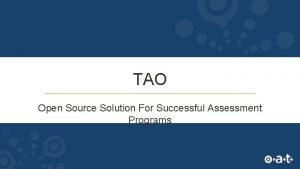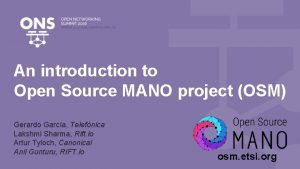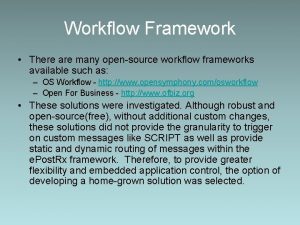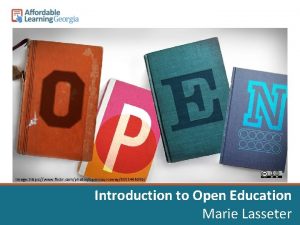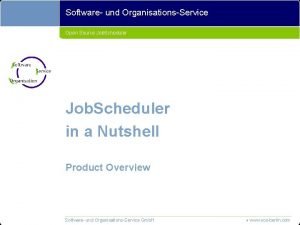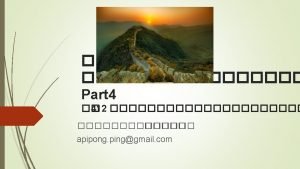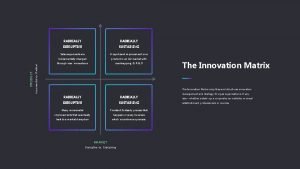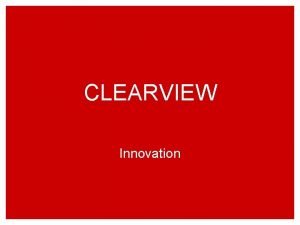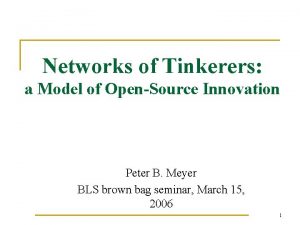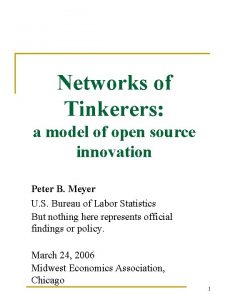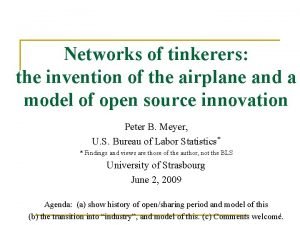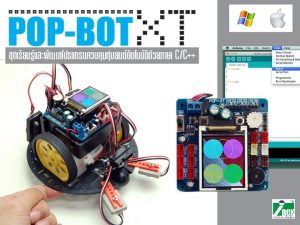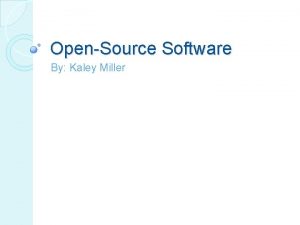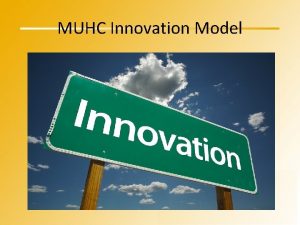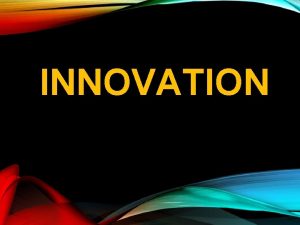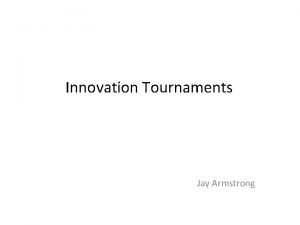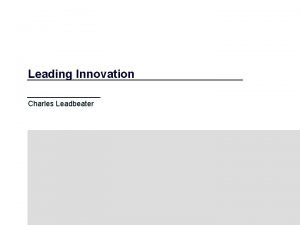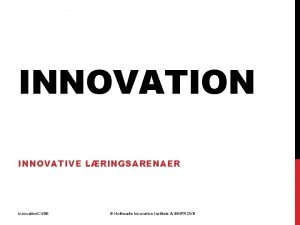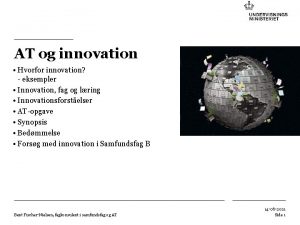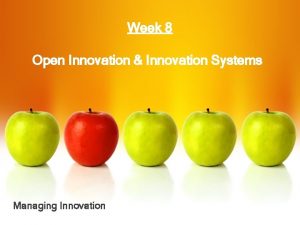Networks of Tinkerers a model of opensource innovation




















- Slides: 20

Networks of Tinkerers: a model of open-source innovation Peter B. Meyer Office of Productivity and Technology, U. S. Bureau of Labor Statistics At OSS 2007, June 14, 2007 All views expressed in this paper are those of the author and do not necessarily reflect the views or policies of the U. S. Bureau of Labor Statistics. 1

Open-source technologies q q q Goal here: make micro model of individuals creating open-source technology Defn: Advanced through openly-shared designs Open source software Early microcomputers at Homebrew Club, 1975 Development of first airplanes n n n Clearly documented, slowly over decades Since 1860 s: aeronautical journals and conferences 1894 – Octave Chanute’s overview book 1903 – Wrights fly famous powered glider 1910 – an industry exists 2

Chanute’s 1894 book Progress in Flying Machines cites 200 experimenters, from all over Experimenter / group Pages Maxim 33 Lilienthal Penaud Mouillard Hargrave 31 22 21 19 Moy Le Bris Langley Wenham Phillips 19 17 16 15 14 location (background) Britain (US) Germany France Algeria, Egypt (Fr) Australia (Br) Britain France US Britain Later technological histories treat these top several as central. Their findings were mostly public. Patents in the US and Germany look different – there are many patentees, with one each. Chanute says many are “worthless”. Hargrave says it’s too soon to patent or keep secrets. 3

Hargrave box kites experiment, 1894 He thinks all aerial navigation worked should be published and nothing patented till something really works. 4

Lilienthal curved wing experiments n n For decades Otto Lilienthal studied birds and experimented on shapes in wind Published Birdflight as the Basis of Aviation, 1889 5

Motivations of experimenters n n n Would like to fly Curiosity, interest in the problem Prestige, recognition Belief in making world a better place Make one nation safer Nobody refers to expected profits “. . . A desire takes possession of man. He longs to soar upward and to glide, free as the bird. . . ” -- Otto Lilienthal 1889 “The glory of a great discovery or an invention which is destined to benefit humanity [seemed] dazzling. . Enthusiasm seized [us] at an early age. ” - Gustav Lilienthal 6

For micro model n Assume there are motivated tinkerers n Assume total technological uncertainty q q no identifiable feasible market/product now so no competition Can show The tinkerers would share information 7

8

9

10

11

Investment to gain more from network n n Programmers specialize on aspects of a project q avoids duplication; develops focused skills and tools And standardize code interfaces (or design, or part) q so some progress by other tinkerers will snap right in In model: n Tinkerers receive fraction f of progress by others n Suppose for cost cs, could raise that inflow to f 2 > f 12

Specialization and standardization n That’s worth doing if: n A player benefits more from this if, ceteris paribus: q other tinkerers produce a large flow of innovations p 2; gain in useful innovations from the others (f 2 -f) is large. q cost cs is small; For β=. 95, p=. 07, f 2=. 55, f=. 5, payback is 1. 33; worth q usual investment. Specialization and standardization are natural in tinkerers’ network. Tinkerers in model would be willing 13 to pay.

Role for author / moderator / evangelist n n Chanute corresponded with, visited, introduced experimenters, and published book In model: A tinkerer’s best opportunity for a better program may be evangelism – give up p 1 for p 2 q q To welcome future tinkerers who could generate progress To avoid duplicate efforts, thru standards and specialization authors/evangelists are another kind of specialist tinkerer Octave Chanute, 1894: “The writer’s object in preparing these articles was threefold: 1. To satisfy himself whether. . . men might reasonably hope eventually to fly. . . 2. To save. . . effort on the part of experimenters trying again devices which have already failed. 3. To. . . render it less chimerical. . . to experiment with a flying machine. . ” Analogously: Lilienthal’s public demonstrations; Felsenstein at Homebrew; open source programmers Stallman, Torvalds, etc. 14

Wright brothers 1900 -1902 left the network to start a business q Wrights were of open-source type. "I am an enthusiast. . . I wish to. . . if possible add my mite to help on the future worker who will attain final success. " -- Wilbur Wright, 1899 "At the beginning we had no thought of recovering what we were expending, which was not great. . . " -- Orville Wright, How We Invented the Airplane, [1953] p. 87 q q q They published, spoke at meetings, had visits from Chanute and others, showed everything. In late 1902 and subsequently they were more secretive. Why? Probably their patented wings from their wind tunnel experiments. Analogously, Apple founders left Homebrew Club 15

Intellectual property and secrecy In each episode (airplanes, computers, open source software) many people want to avoid intellectual property and/or secrecy Hargrave thought all aerial navigation work should be published and nothing patented till something really worked. Chanute wanted to get all information out in the open Analogously: Stallman, Fogel, other open source programmers In model: intellectual property payments for sharing results of experiments would just introduce noise and friction on net. Incentives aren’t needed, and don’t help, and there are no profits to split. 16

Entrepreneurial exits in model Suppose a tinkerer envsions how to make a profit from project A worth more than the present value of staying in the tinkerers’ network. Then tinkerer can exit network agreement n conducts directed R&D n stops listening to network n becomes an entrepreneur 17

Modeling exit to startup firm n n n Suppose each player tries to see through the technological uncertainty and imagine selling a product based on A. At the start of each turn with probabilities π0 and π1 each player envisions how to do this, and exits to take a large expected utility payoff of M for quitting the network and starting a firm. Anticipating this could happen they agree on a fee x to exit the network Then the payoff is something like: Previous results hold, while the tinkerer’s network exists But incentives change once he makes the quantum leap to being an entrepreneur. 18

Alternative models of invention (1) Network: a population of agents with interest in a problem (a 0), worthwhile opportunities (p), information flows between them (f) experimentation and socially constructed “progress” No pool of information, or incentive structure, or technical measure of improvement. (2) Race to be first (space race; genome project) (3) Collective invention (Allen, 1983) but those are (a) firms, (b) not paying costs to experiment (4) To earn income or wealth indirectly q q q Start company, or license patented invention signal to employers; get hired as engineer (Lerner and Tirole, 2002)19

Conclusion n Key assumptions of this model: q q q n This generates inventions, as by: q q n motivated tinkerers, perceiving progress no perceived path to profit cheap communication Hobbyists “Skunkworks” inside organizations Basic researchers Better communications – an effect of the Internet is that it enables networks. For our session: an industry can arise this way 20
 Innovation for the sake of innovation
Innovation for the sake of innovation Disruptive and radical innovation
Disruptive and radical innovation Openflow enabling innovation in campus networks
Openflow enabling innovation in campus networks Openflow enabling innovation in campus networks
Openflow enabling innovation in campus networks Ip address management freeware
Ip address management freeware Opensource sdn
Opensource sdn Open source assessment platform
Open source assessment platform Wckcs
Wckcs Opensource mano
Opensource mano Opensource workflow
Opensource workflow Opensource.com
Opensource.com Opensource.com
Opensource.com Open source scheduler
Open source scheduler Ids opensource
Ids opensource Datagram networks and virtual circuit networks
Datagram networks and virtual circuit networks Basestore iptv
Basestore iptv Fugle innovation process model
Fugle innovation process model Ibm business model
Ibm business model 4ps of innovation space
4ps of innovation space Snmp osi model
Snmp osi model Osi model in computer network
Osi model in computer network



